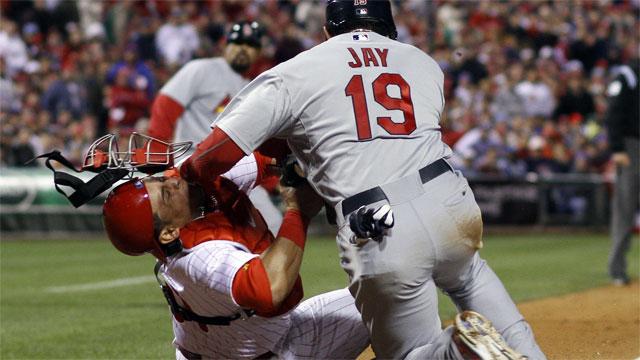The ability to flatten a catcher who is blocking (or, let’s face it, close to blocking) home plate has been in baseball since near time immemorial. Outlawing or otherwise mitigating home-plate collisions, or any part of the game that’s been around as long, is bound to ruffle a few purist feathers. Baseball is a game steeped in history and tradition, and it does not change easily.
There will, of course, be those who find this borderline sacrilegious, citing that baseball has always been played a specific way and to change that way is an abomination. And there will be those who say that continuing to do something just because that’s the way it has always been is one of the worst reasons to continue doing anything.
I get both sides of the argument, but I agree with only one.
At the beginning of every MLB game there is an announcement played over the stadium’s PA system that declares “baseball is an inherently dangerous sport.” And it is. Men use clubs to hit things, and those things are flying at their bodies at 100 mph. They train themselves to run as fast as possible, then routinely run into walls or barriers. They wear metal spikes and slide purposefully into one another. They charge each other when their egos are threatened. They promise payback when homers are celebrated incorrectly. They even throw at one another as a consequence for being snubbed at public events. Baseball is not a contact sport, but you can still get your fair share of contact, malicious or accidental.
So it’s not like the players don’t know the danger exists. The problem is, some injuries in sports are unavoidable while others are. Take off the “baseball players are commodities” glasses for a second and understand that they are people. They’re well compensated for playing a game that makes us think irrationally about how they should behave, but they’re people all the same who will have life after baseball. Lots of life, actually, since the average career ends when a player’s in his late 20s or early 30s. And the quality of that life can be in severe jeopardy thanks to something like a needless concussion, or a destroyed knee or ankle.
While many big leaguers have guaranteed money coming in should they get injured, there are a great many more who do not. The fastest way to find yourself out of the game forever is to get hurt and not bounce back. Why risk a career, the amount of sacrifice it took to acquire it, and the quality of life a player has after it’s over on something that can be avoided? While baseball is “inherently dangerous,” the MLB must also be inherently concerned with the safety of those who play it.
I mention the compensation of players in tandem with their humanity because, ironically, the anatomy of many arguments against home-plate-collision rule changes always seems to include at least one part, “they’re paid enough, they can take the risk.” Actually, they are paid so much it makes sense to avoid the risk. This bravado of “I’d get run over for a million dollars” reeks of provinciality since, if your favourite team’s catcher got ruined for a season—or a career—and cost your favourite team a chance at a title, you’d probably feel completely different about what has always been and should always be part of the game.
It’s also worth noting that objections to player-safety-related rules changes are not new to baseball. It took roughly 50 years after the first hitter was struck in the head and killed by a pitch to make batting helmets a full-time part of the game. Even after witnessing a string of horrid line drives into pitchers’ heads in the last few seasons, the pitchers would still rather risk their health than be encumbered by protective headgear. Beyond safety, baseball has been slow to enact change. Slow to ban steroids. Slow to add instant replay. Slow to ban stimulants. It’s a very traditionalist sport that does not like breaking from its course.
But it must. It must be willing to adopt things that make it safer. Not just for the players in the game now, but for the organizations that pay the players massive sums, and the economies that exist around those players and their teams. Whatever perceived excitement it loses by preventing collisions, it gains by preventing the loss of talented players from competitive lineups.
Dirk’s next book, Bigger Than The Game, comes out Feb. 25. Pre-order and save 15 to 25 percent off the cover price.









